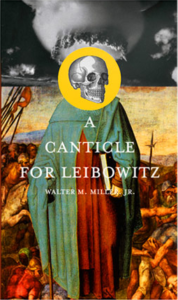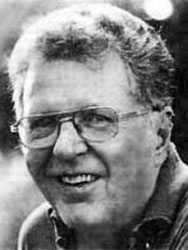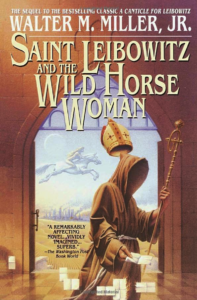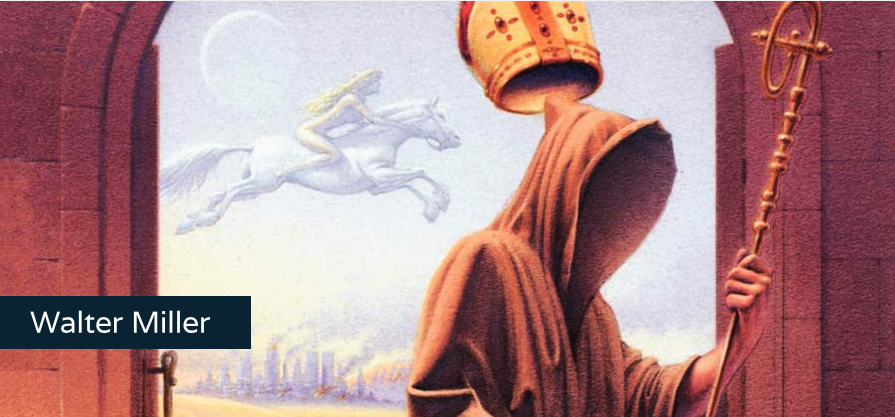This was published as an Afterword to the Gallimard (French) edition of Miller’s Saint Leibowitz and the Wild Horse Woman.
A CANTICLE FOR MILLER; or, How I Met Saint Leibowitz and the Wild Horse Woman but not Walter M. Miller, Jr.
I am a science fiction writer, a dicey business at best.
In November, 1995, I got a call from Don Congdon, a literary agent I knew by reputation but had never met. Congdon’s a player. He represents William Styron and Ray Bradbury, among others.
He asked if I had ever heard of a book called A Canticle for Leibowitz. I said yes, I had.
 Who hasn’t? Canticle is one of the few science fiction books not only known but read outside the field (unlike, say, Dune or Stranger in a Strange Land, which render up their pleasures only to those already attuned to the genre). A novel of nuclear anxiety written in the 1950s, it tells the story of an order of monks in the Southwest and their efforts to keep scientific knowledge alive in the new Dark Age after the “Flame Deluge” or nuclear war. Leibowitz Abbey, and the neighboring village of Sanly Bowitz, are both named after a Los Alamos scientist who became a monk, was martyred by a mob and is—just maybe—a saint. Leibowitz was Jewish, the joke of the title.
Who hasn’t? Canticle is one of the few science fiction books not only known but read outside the field (unlike, say, Dune or Stranger in a Strange Land, which render up their pleasures only to those already attuned to the genre). A novel of nuclear anxiety written in the 1950s, it tells the story of an order of monks in the Southwest and their efforts to keep scientific knowledge alive in the new Dark Age after the “Flame Deluge” or nuclear war. Leibowitz Abbey, and the neighboring village of Sanly Bowitz, are both named after a Los Alamos scientist who became a monk, was martyred by a mob and is—just maybe—a saint. Leibowitz was Jewish, the joke of the title.
The first major post-holocaust SF novel, Canticle is a “fix-up” of three related novellas, which cover some two thousand years, during which science is reborn and destroys civilization once again. “It was a good year for the buzzards” is Miller’s persistent refrain. He didn’t, to put it mildly, believe in Progress.
Since its publication in 1959, Canticle has never been out of print, and has sold millions of copies. It regularly makes high school and college reading lists. Even in Catholic schools.

Don Congdon told me that Canticle’s author, Walter M. Miller, Jr., his client, had been working on a sequel for some six or seven years, but the work had “hit a stone wall.” Miller was over seventy. His health was bad, and he’d been severely depressed for years. Congdon had suggested hiring a writer/editor to help finish the book and Miller had agreed. Would I be willing to take a look at the manuscript?
I said yes. I was thinking, Hell yes.
Like millions of others, I had read, loved and never forgotten A Canticle for Leibowitz. More to the point, I was looking looking for work. I make half my living through freelance hack work for New York publishers—editing, ghost writing, novelizations, young adult books, cover copy, etc. Some of it is interesting (Car Talk with Click and Clack), some of it dreary (No Names Here). My own most recent novel, Pirates of the Universe, got good reviews, but hadn’t made much money. I was full fathom five on my credit cards, the freelancer’s braided plastic lifeline. Understanding this, my good friend (and editor) Alice Turner of Playboy had suggested me for the job, when Congdon had told her of Miller’s problems during one of their long, elegant, literary lunches.
I called Alice to thank her, and went by Congdon’s office on Fifth Avenue the next morning to pick up the manuscript. I was expecting a mess. The uncompleted, often uncompletable follow-up to the acclaimed bestseller is a sad but common second act in twentieth century American literature. Remember the sequel to Invisible Man? Or Call it Sleep? Or Gone with the Wind, for that matter?
Me neither.
Congdon gave me a box that weighed more than a small dog. I hauled it home before opening it. The manuscript inside was almost 600 pages long! I have been a writer long enough to know what it means to get stuck on a book. You meander, you fiddle, you rewrite—whatever. Miller had described his state to Congdon as like “trying to spit through a screen.” So I was expecting, as I said, a mess.
I read all that afternoon and most of that night. I finished the book at ten the next morning. It was brilliant. It was beautiful. It was almost perfect. There wasn’t a line or a word out of place. This was no rough draft or heap of fragments, but a seamless, exotic and incredibly rich masterpiece that motored along confidently, elegantly and masterfully for 592 pages—
And then stopped short.
It even had a title: Saint Leibowitz and the Wild Horse Woman. The story takes place at about the time of the second Canticle novella, the 34th century. It’s told from the point of view of a Leibowitzan monk, Blacktooth, and it concerns the struggle between the Church in Denver, and a rude and violent new empire in Texarkana. Caught in the middle are the mutant “spooks” who live in the hills, and the horse nomads who rule the plains. Guns have just been reinvented, and Blacktooth travels with a worldly cardinal called Brownpony who is secretly arming the spooks and the nomads to fight on the side of the Church. To complicate things there is, of course, a girl: a beautiful, elusive and irreverent young “spook.” And there’s more. Lots more.
I called Congdon and told him I loved the book and wanted the job. Congdon sent my CV to Miller, who wrote back simply: “I’ve never heard of this guy but he sounds okay to me.” Earlier, he had assured Congdon that “any idiot with a sense of humor can finish this book.”
I was in the ball park anyway.
While we waited for the okay from Bantam, Congdon filled me in on some history. Saint Leibowitz and the Wild Horse Woman had been sold to Lou Aronica at Bantam some seven years before for what publishers politely call “mid six figures.” Aronica was long gone, first to Berkley and then Avon, and we needed a go-ahead from Bantam’s current leadership for me to finish the project. Most of the money was still unpaid, and it was not certain that they would want the book after all these years. But Congdon was sure he would be able to place it somewhere if need be. So was I.
I cleared my decks for the project. I started taking notes, making plans, getting ready to get to work. I reread Canticle and was amazed how well it held up. Congdon and my agent, Susan Protter, worked out a tentative deal that would get me out of debt. I was to get no credit on the cover, but that was okay with me. People in the genre and in the business would know I had done the job.
We were still waiting to hear from Bantam when Congdon called me over Christmas, saying, “I have some bad news. Walter killed himself yesterday.”
I was saddened and dismayed. I was also disappointed. Though I was assured that I would probably still get the job, I had looked forward to meeting Miller and getting his approval of my work. Congdon disabused me of that notion. “I was his agent for forty years and we never met in person.”
 The family was understandably reluctant to release details of Miller’s death, but gradually word leaked out. The irony was sharp: the third section of Canticle is a moving polemic against suicide. There were mixed feelings in the genre. Miller had not been popular. After his initial success he had made enemies, then withdrawn from the SF community altogether. He had a prickly personality. He was estranged from his family as well. The estate was to be handled by his grandaughter, who had made the effort to get to know him. She was an Arafat, raised in Texas with roots in the Middle East. This complex cultural legacy was another irony, perhaps appropriate to a writer who was so deeply conflicted about Catholicism and the West.
The family was understandably reluctant to release details of Miller’s death, but gradually word leaked out. The irony was sharp: the third section of Canticle is a moving polemic against suicide. There were mixed feelings in the genre. Miller had not been popular. After his initial success he had made enemies, then withdrawn from the SF community altogether. He had a prickly personality. He was estranged from his family as well. The estate was to be handled by his grandaughter, who had made the effort to get to know him. She was an Arafat, raised in Texas with roots in the Middle East. This complex cultural legacy was another irony, perhaps appropriate to a writer who was so deeply conflicted about Catholicism and the West.
Bantam finally gave their approval and I went to work. Miller had left a fairly detailed outline showing where he wanted the book to go. Some of it was in the form of letters to Congdon; some was notes to Aronica and himself, including several scenes complete with dialogue. I wrote the last hundred-odd pages of the book according to Miller’s instructions. I used every word of his dialogue and description, and even worked in scraps from Canticle for continuity. Miller was big on repeated images: buzzards, mules, and one old Wandering Jew.
Miller always insisted he was not a “stylist,” but that doesn’t mean he wrote like Ian Fleming. He was a careful and precise writer, with a dry sense of humor. He strove for clarity, which is not the same as directness. It took a little doing to get into his voice, but once I did, it seemed perfectly natural. I was steeped in the setting and the characters.
As an editor and book doctor, I know how to stay out of the way and make my contribution transparent. I usually do it by writing down—how much more enjoyable to write up, emulating a master! I was playing with Michael Jordan, or at least Larry Bird, and as they say in the NBA, it raised the level of my game.
As I worked on the book, I was very conscious of how lucky I was. Alice Turner’s recommendation had gotten me the job without a search, and while I am definitely the right guy, there are several other SF writers who could have done just as well. Michael Bishop, John Kessel and Karen Joy Fowler come immediately to mind. There’s also a whole host out there who could have messed it up unspeakably.
As I worked, I fell in love with the book, and oddly enough, with Miller himself. I can’t imagine two more dissimilar writers. I am definitely a stylist (at least I like to think so) and my politics are materialist, Marxist and modernist. Miller’s history is cyclical (nothing gets better) and his heroes are holy fools. He expects little from people, yet loves and forgives them, over and over—which is what Christianity is all about. I guess.
Five months later the job was done. I turned it in, and it was okayed by the agent and by the family, and finally by Bantam. In the meantime, my editor, Tom Dupree, left (common enough in publishing). I was fortunate in his replacement, Pat LoBrutto, who is not only a solid SF pro, but a literary mensch who was Walter Tevis’s editor at Doubleday.
Thanks to Pat (and Congdon), I was allowed to approve the copy-editing and the flap copy. I spent a weeks working out Miller’s often puzzling geography, including the location of “New Rome,” for Bantam’s endpaper maps.
The finished book was and still is Miller’s book entirely. Whatever I did, I did writing as him; and it is, I hope, transparent. I am pleased and proud to be part of a unique success story with a happy ending. Unlike the long-awaited sequels to Time and Again (Finney is another of Congdon’s clients) or Roth’s Call it Sleep, Walter M. Miller Jr.’s Saint Leibowitz and the Wild Horse Woman is a masterpiece in its own right, fully worthy of its author and its predescessor.
It ate him up, but he did it.
I’m only sorry I never got to meet the man I worked with so long and so intensely, even after his death. But that was never in the cards. Lucius Shepard told me a story right after I got the job. When he was living in south Florida, Lucius received a fan letter (an unheard of thing!) from Walt Miller, who lived only a few miles away. It praised his writing at some length. Then, at the bottom, it said: PS: This does not mean I want to meet you!
Good night anyway, sweet prince. And thanks.
(Thanks for your interest in my work. If you enjoyed this little piece, please give a dollar to a homeless person.)

